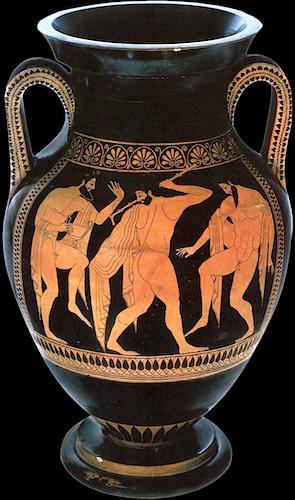Competition
“As never Ephronios [could do]” wrote painter Euthymides after painting his new amphora (an amphora is a type of Greek vase in this shape). Euthymides had a clear sense of achievement and was indeed proud of his work, boastfully challenging his friend and rival—Euphronios. He would see Euphronios often, as well as other painters in the Kerameikos—the potter’s quarter in Athens. They would be curious to see one another’s new work, sometimes with appreciation, sometimes with a bit of jealousy. In the evenings they often had a good time together at a symposium (a kind of ancient Greek male drinking party). They would drink wine mixed with water, become garrulous, loud and—if drinking went on for too long—they might even start singing and even dancing. Perhaps what is depicted on this amphora is a scene similar to those Euthymides witnessed at one of these long parties. Euphronios indeed was a master potter and painter, and Euthymides knew that and had a full appreciation for his work. He thought however, that his figures seemed much more lively, caught in a split of a moment, in a dancing movement.
The beginnings of red-figure painting
Hector departs for war
The vase displays balance and harmony of proportions, with its elegant and graceful shape, and carefully planned pictorial decoration. The main scenes on both sides of the amphora are complemented by a delicate ornament. Despite the beauty of the vase, the potters and painters in ancient Greece did not have the status an artist has in our modern society. Their work was looked upon as a physical labor, not as an activity inspired by the muses. In fact, there was no muse of painting. The decorated vases were produced in large amounts to answer the growing demand of the markets, both in Greece, as well as abroad (especially in Etruria, and in Greek colonies). The Euthymides vase was in fact found in an Etruscan tomb at Vulci in Italy. Many Greek vases survived untouched because the Etruscans buried their deceased in large underground tombs with many everyday objects.
Candela Citations
- Archaic: Euthymides, Three Revelers. Authored by: Katarzyna Minollari. Provided by: Khan Academy. Located at: https://www.khanacademy.org/humanities/art-history/ancient-art-civilizations/greek-art/greek-pottery/a/euthymides-three-revelers. Project: Archaic: Euthymides, Three Revelers. License: CC BY-NC-SA: Attribution-NonCommercial-ShareAlike




